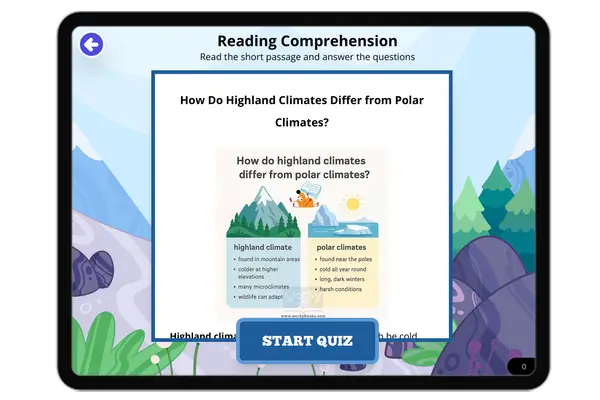How Rainforests Help the Planet — Passage
Rainforests play a critical role in maintaining Earth’s environment. These ecosystems are found in tropical regions near the Equator and are filled with trees, plants, animals, and microbes. Though they cover only about 6% of Earth’s surface, they are essential to the health of the entire planet.
One of the most important functions of rainforests is producing oxygen. Through photosynthesis, plants take in carbon dioxide (CO₂) and release oxygen (O₂). Tropical rainforests like the Amazon help produce around 20% of the world’s oxygen, which humans and animals need to breathe.
Rainforests are also known as carbon sinks. This means they absorb more carbon dioxide than they release. By storing carbon, they help slow down climate change caused by the buildup of greenhouse gases in the atmosphere. The dense vegetation of rainforests holds carbon in leaves, trunks, and soil, making them natural climate protectors.
In addition to climate regulation, rainforests provide habitats for over half of the world’s plant and animal species. These include colorful birds, amphibians, insects, and mammals that often exist nowhere else. This biodiversity makes rainforests a key area for scientific research and discovery.
Rainforests are also valuable to humans. People rely on them for medicines, food, rubber, and building materials. Many rainforest plants have been used to develop treatments for diseases like cancer and malaria. Indigenous communities live sustainably in rainforests and pass on deep ecological knowledge.
Despite their importance, rainforests are being destroyed at an alarming rate due to deforestation for farming, logging, and mining. Scientists, governments, and communities are working to protect these ecosystems through reforestation, protected areas, and education.
Fun Fact: Over 25% of modern medicines come from rainforest plants!
What is one main way rainforests help the planet?
They lower ocean levelsThey release oxygenThey create desertsThey stop earthquakesWhat does the term “carbon sink” mean?
A place that makes carbonA machine that filters carbonA system that stores carbon dioxideA hole full of carbon rocksHow do plants produce oxygen?
By absorbing waterThrough photosynthesisWhen animals sleepFrom lightningWhy are rainforests important to medicine?
They grow herbs to feed animalsThey provide fresh waterMany useful plants grow thereThey grow fastWhat is one danger facing rainforests today?
Too much rainCold wintersDeforestationEarthquakesWhy is rainforest biodiversity valuable?
It makes farming easierIt reduces oxygen levelsIt supports rare and unique speciesIt causes floodingWhat is the main idea of the passage?
Rainforests are dangerous placesRainforests are home to people onlyRainforests help the planet in many waysRainforests are all in AfricaIf a rainforest is destroyed, what might happen?
Less oxygen and more CO₂ in the airMore wildfires in the desertLess snow in the mountainsEarthquakes increase worldwide









